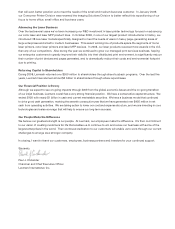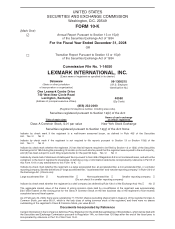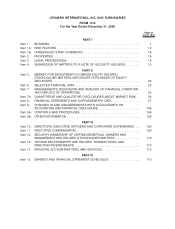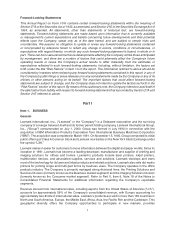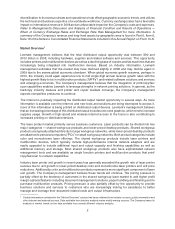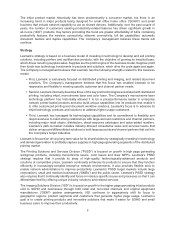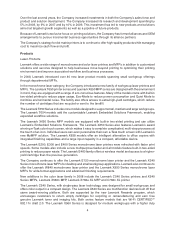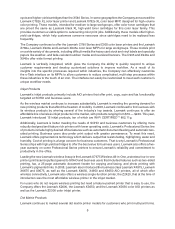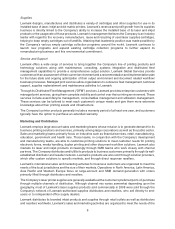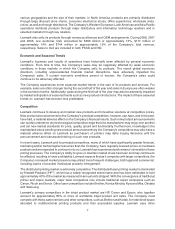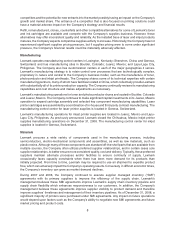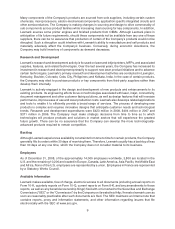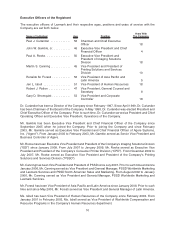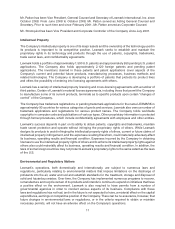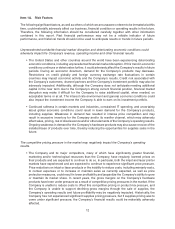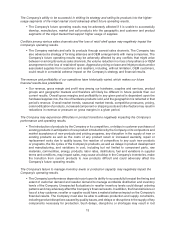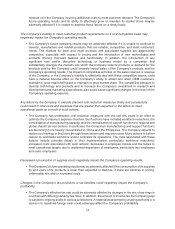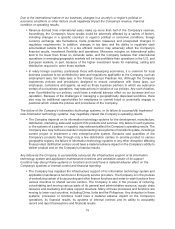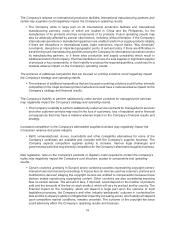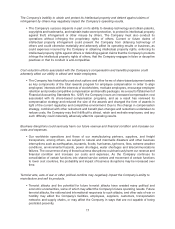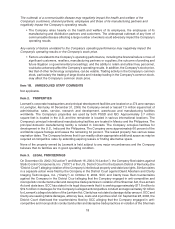Lexmark 2008 Annual Report Download - page 14
Download and view the complete annual report
Please find page 14 of the 2008 Lexmark annual report below. You can navigate through the pages in the report by either clicking on the pages listed below, or by using the keyword search tool below to find specific information within the annual report.competitors and the potential for new entrants into the market possibly having an impact on the Company’s
growth and market share. The entrance of a competitor that is also focused on printing solutions could
have a material adverse impact on the Company’s strategy and financial results.
Refill, remanufactured, clones, counterfeits and other compatible alternatives for some of Lexmark’s toner
and ink cartridges are available and compete with the Company’s supplies business. However, these
alternatives may offer inconsistent quality and reliability. As the installed base of laser and inkjet products
matures, the Company expects competitive supplies activity to increase. Historically, the Company has not
experienced significant supplies pricing pressure, but if supplies pricing were to come under significant
pressure, the Company’s financial results could be materially adversely affected.
Manufacturing
Lexmark operates manufacturing control centers in Lexington, Kentucky; Shenzhen, China; and Geneva,
Switzerland; and has manufacturing sites in Boulder, Colorado; Juarez, Mexico; and Lapu-Lapu City,
Philippines. The Company also has customization centers in each of the major geographies it serves.
Lexmark’s manufacturing strategy is to retain control over processes that are technologically complex,
proprietary in nature and central to the Company’s business model, such as the manufacture of toner,
photoconductor and inkjet printheads. The Company shares some of its technical expertise with certain
manufacturing partners, many of whom have facilities located in China, which collectively provide Lexmark
with substantially all of its printer production capacity. The Company continually reviews its manufacturing
capabilities and cost structure and makes adjustments as necessary.
Lexmark’s manufacturing operations for toner and photoconductor drums are located in Boulder, Colorado
and Juarez, Mexico. The Company continues to make significant capital investments in its Juarez, Mexico
operation to expand cartridge assembly and selected key component manufacturing capabilities. Laser
printer cartridges are assembled by a combination of in-house and third-party contract manufacturing. The
manufacturing control center for laser printer supplies is located in Geneva, Switzerland.
Lexmark’s manufacturing operations for inkjet printer supplies are located in Juarez, Mexico and Lapu-
Lapu City, Philippines. As previously announced, Lexmark closed the Chihuahua, Mexico inkjet printer
supplies manufacturing operations on December 31, 2008. The manufacturing control center for inkjet
supplies is located in Geneva, Switzerland.
Materials
Lexmark procures a wide variety of components used in the manufacturing process, including
semiconductors, electro-mechanical components and assemblies, as well as raw materials, such as
plastic resins. Although many of these components are standard off-the-shelf parts that are available from
multiple sources, the Company often utilizes preferred supplier relationships, and in certain cases sole
supplier relationships, to better ensure more consistent quality, cost and delivery. Typically, these preferred
suppliers maintain alternate processes and/or facilities to ensure continuity of supply. Lexmark
occasionally faces capacity constraints when there has been more demand for its products than
initially projected. From time to time, Lexmark may be required to use air shipment to expedite product
flow, which can adversely impact the Company’s operating results. Conversely, in difficult economic times,
the Company’s inventory can grow as market demand declines.
During 2007 and 2008, the Company continued to execute supplier managed inventory (“SMI”)
agreements with its primary suppliers to improve the efficiency of the supply chain. Lexmark’s
management believes these SMI agreements improve Lexmark’s supply chain inventory pipeline and
supply chain flexibility which enhances responsiveness to our customers. In addition, the Company’s
management believes these agreements improve supplier visibility to product demand and therefore
improve suppliers’ timeliness and management of their inventory pipelines. As of December 31, 2008, a
significant majority of printers were purchased under SMI agreements. Any impact on future operations
would depend upon factors such as the Company’s ability to negotiate new SMI agreements and future
market pricing and product costs.
8


